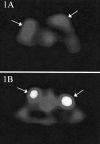Using positron emission tomography with [(18)F]FDG to predict tumor behavior in experimental colorectal cancer
- PMID: 11494112
- PMCID: PMC1505592
- DOI: 10.1038/sj.neo.7900147
Using positron emission tomography with [(18)F]FDG to predict tumor behavior in experimental colorectal cancer
Abstract
This study investigates the relationship between FDG uptake as determined by positron emission tomography (PET) imaging and rates of tumor growth, cellular GLUT1 transporter density, and the activities of hexokinase and glucose-6-phosphatase in a solid tumor implant model. Five different human colorectal xenografts of different growth properties were implanted in athymic rats and evaluated by dynamic (18)F-FDG-PET. The phosphorylating and dephosphorylating activities of the key glycolytic enzymes, hexokinase and glucose-6-phosphatase, were measured in these tumor types by spectrophotometric assays and the expression of GLUT1 glucose transporter protein was determined by immunohistochemistry. Correlations among FDG accumulation, hexokinase activity, and tumor doubling time are reported in these colon xenografts. The results indicate that the activity of tumor hexokinase may be a marker of tumor growth rate that can be determined by (18)F-FDG-PET imaging. PET scanning may not only be a useful tool for staging patients for extent of disease, but may provide important prognostic information concerning the proliferative rates of malignancies.
Figures





Similar articles
-
Regulation of 18F-FDG accumulation in colorectal cancer cells with mutated KRAS.J Nucl Med. 2014 Dec;55(12):2038-44. doi: 10.2967/jnumed.114.142927. Epub 2014 Nov 5. J Nucl Med. 2014. PMID: 25453050
-
Using dual-tracer PET to predict the biologic behavior of human colorectal cancer.J Nucl Med. 2009 Nov;50(11):1857-64. doi: 10.2967/jnumed.109.064238. Epub 2009 Oct 16. J Nucl Med. 2009. PMID: 19837754
-
Relationship between retention index in dual-phase (18)F-FDG PET, and hexokinase-II and glucose transporter-1 expression in pancreatic cancer.J Nucl Med. 2002 Feb;43(2):173-80. J Nucl Med. 2002. PMID: 11850481
-
Relationship between glucose transporter, hexokinase and FDG-PET in esophageal cancer.Hepatogastroenterology. 2005 Mar-Apr;52(62):486-90. Hepatogastroenterology. 2005. PMID: 15816463
-
The rate-limiting step for tumor [18F]fluoro-2-deoxy-D-glucose (FDG) incorporation.Nucl Med Biol. 2001 Jan;28(1):1-4. doi: 10.1016/s0969-8051(00)00177-3. Nucl Med Biol. 2001. PMID: 11182558 Review. No abstract available.
Cited by
-
Dysregulation of Glucose Metabolism by Oncogenes and Tumor Suppressors in Cancer Cells.Asian Pac J Cancer Prev. 2018 Sep 26;19(9):2377-2390. doi: 10.22034/APJCP.2018.19.9.2377. Asian Pac J Cancer Prev. 2018. PMID: 30255690 Free PMC article. Review.
-
Correlation of GLUT-1 overexpression, tumor size, and depth of invasion with 18F-2-fluoro-2-deoxy-D-glucose uptake by positron emission tomography in colorectal cancer.Dig Dis Sci. 2006 Dec;51(12):2198-205. doi: 10.1007/s10620-006-9428-2. Epub 2006 Nov 2. Dig Dis Sci. 2006. PMID: 17080242
-
Promise and progress for functional and molecular imaging of response to targeted therapies.Pharm Res. 2007 Jun;24(6):1172-85. doi: 10.1007/s11095-007-9250-3. Epub 2007 Mar 24. Pharm Res. 2007. PMID: 17385018 Review.
-
Expression of Glut-1 and HK-II in Pancreatic Cancer and Their Impact on Prognosis and FDG Accumulation.Transl Oncol. 2016 Dec;9(6):583-591. doi: 10.1016/j.tranon.2016.08.004. Transl Oncol. 2016. PMID: 27916293 Free PMC article.
-
Prognostic value of 18-fluorodeoxyglucose positron emission tomography-computed tomography in resectable colorectal cancer.World J Gastroenterol. 2012 Sep 28;18(36):5072-7. doi: 10.3748/wjg.v18.i36.5072. World J Gastroenterol. 2012. PMID: 23049216 Free PMC article.
References
-
- Warburg O. On the origin of cancer cells. Science. 1956;123:309–314. - PubMed
-
- Younes M, Lechago LV, Somoano JR, Mosharaf M, Lechago J. Wide expression of the human erythrocyte glucose transporter Glut1 in human cancers. Cancer Res. 1996;56:1164–1167. - PubMed
-
- Brown RS, Leung JY, Fisher SJ, Frey KA, Ethier SP, Wahl RL. Intratumoral distribution of tritiated FDG in breast carcinoma: correlation between Glut-1 expression and FDG uptake. J Nucl Med. 1996;37:1042–1047. - PubMed
-
- Higashi T, Tamaki N, Torizuka T, Nakamoto Y, Sakahara H, Kimura T, Honda T, Inokuma T, Katsushima S, Ohshio G, Imamura M, Konishi J. FDG uptake, GLUT-1 glucose transporter and cellularity in human pancreatic tumors. J Nucl Med. 1998;39:1727–1735. - PubMed
-
- Chung JK, Lee YJ, Kim C, Choi SR, Kim M, Lee K, Jeong JM, Lee DS, Jang JJ, Lee MC. Mechanisms related to [18F] fluorodeoxyglucose uptake of human colon cancers transplanted in nude mice. J Nucl Med. 1999;40:339–346. - PubMed
Publication types
MeSH terms
Substances
Grants and funding
LinkOut - more resources
Full Text Sources
Other Literature Sources
Medical
Miscellaneous
